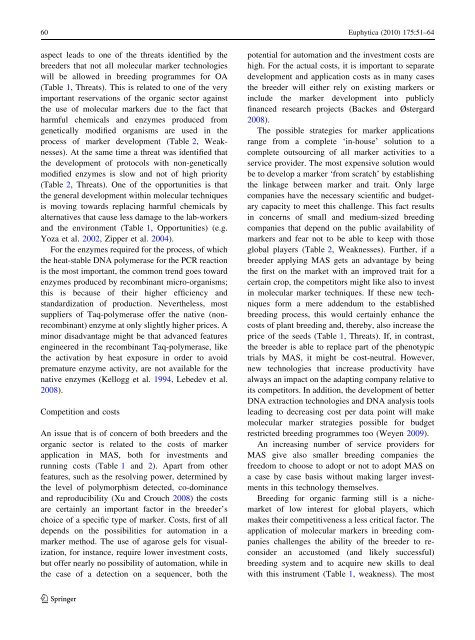The role of molecular markers and marker assisted selection in ...
The role of molecular markers and marker assisted selection in ...
The role of molecular markers and marker assisted selection in ...
You also want an ePaper? Increase the reach of your titles
YUMPU automatically turns print PDFs into web optimized ePapers that Google loves.
60 Euphytica (2010) 175:51–64<br />
aspect leads to one <strong>of</strong> the threats identified by the<br />
breeders that not all <strong>molecular</strong> <strong>marker</strong> technologies<br />
will be allowed <strong>in</strong> breed<strong>in</strong>g programmes for OA<br />
(Table 1, Threats). This is related to one <strong>of</strong> the very<br />
important reservations <strong>of</strong> the organic sector aga<strong>in</strong>st<br />
the use <strong>of</strong> <strong>molecular</strong> <strong><strong>marker</strong>s</strong> due to the fact that<br />
harmful chemicals <strong>and</strong> enzymes produced from<br />
genetically modified organisms are used <strong>in</strong> the<br />
process <strong>of</strong> <strong>marker</strong> development (Table 2, Weaknesses).<br />
At the same time a threat was identified that<br />
the development <strong>of</strong> protocols with non-genetically<br />
modified enzymes is slow <strong>and</strong> not <strong>of</strong> high priority<br />
(Table 2, Threats). One <strong>of</strong> the opportunities is that<br />
the general development with<strong>in</strong> <strong>molecular</strong> techniques<br />
is mov<strong>in</strong>g towards replac<strong>in</strong>g harmful chemicals by<br />
alternatives that cause less damage to the lab-workers<br />
<strong>and</strong> the environment (Table 1, Opportunities) (e.g.<br />
Yoza et al. 2002, Zipper et al. 2004).<br />
For the enzymes required for the process, <strong>of</strong> which<br />
the heat-stable DNA polymerase for the PCR reaction<br />
is the most important, the common trend goes toward<br />
enzymes produced by recomb<strong>in</strong>ant micro-organisms;<br />
this is because <strong>of</strong> their higher efficiency <strong>and</strong><br />
st<strong>and</strong>ardization <strong>of</strong> production. Nevertheless, most<br />
suppliers <strong>of</strong> Taq-polymerase <strong>of</strong>fer the native (nonrecomb<strong>in</strong>ant)<br />
enzyme at only slightly higher prices. A<br />
m<strong>in</strong>or disadvantage might be that advanced features<br />
eng<strong>in</strong>eered <strong>in</strong> the recomb<strong>in</strong>ant Taq-polymerase, like<br />
the activation by heat exposure <strong>in</strong> order to avoid<br />
premature enzyme activity, are not available for the<br />
native enzymes (Kellogg et al. 1994, Lebedev et al.<br />
2008).<br />
Competition <strong>and</strong> costs<br />
An issue that is <strong>of</strong> concern <strong>of</strong> both breeders <strong>and</strong> the<br />
organic sector is related to the costs <strong>of</strong> <strong>marker</strong><br />
application <strong>in</strong> MAS, both for <strong>in</strong>vestments <strong>and</strong><br />
runn<strong>in</strong>g costs (Table 1 <strong>and</strong> 2). Apart from other<br />
features, such as the resolv<strong>in</strong>g power, determ<strong>in</strong>ed by<br />
the level <strong>of</strong> polymorphism detected, co-dom<strong>in</strong>ance<br />
<strong>and</strong> reproducibility (Xu <strong>and</strong> Crouch 2008) the costs<br />
are certa<strong>in</strong>ly an important factor <strong>in</strong> the breeder’s<br />
choice <strong>of</strong> a specific type <strong>of</strong> <strong>marker</strong>. Costs, first <strong>of</strong> all<br />
depends on the possibilities for automation <strong>in</strong> a<br />
<strong>marker</strong> method. <strong>The</strong> use <strong>of</strong> agarose gels for visualization,<br />
for <strong>in</strong>stance, require lower <strong>in</strong>vestment costs,<br />
but <strong>of</strong>fer nearly no possibility <strong>of</strong> automation, while <strong>in</strong><br />
the case <strong>of</strong> a detection on a sequencer, both the<br />
potential for automation <strong>and</strong> the <strong>in</strong>vestment costs are<br />
high. For the actual costs, it is important to separate<br />
development <strong>and</strong> application costs as <strong>in</strong> many cases<br />
the breeder will either rely on exist<strong>in</strong>g <strong><strong>marker</strong>s</strong> or<br />
<strong>in</strong>clude the <strong>marker</strong> development <strong>in</strong>to publicly<br />
f<strong>in</strong>anced research projects (Backes <strong>and</strong> Østergard<br />
2008).<br />
<strong>The</strong> possible strategies for <strong>marker</strong> applications<br />
range from a complete ‘<strong>in</strong>-house’ solution to a<br />
complete outsourc<strong>in</strong>g <strong>of</strong> all <strong>marker</strong> activities to a<br />
service provider. <strong>The</strong> most expensive solution would<br />
be to develop a <strong>marker</strong> ‘from scratch’ by establish<strong>in</strong>g<br />
the l<strong>in</strong>kage between <strong>marker</strong> <strong>and</strong> trait. Only large<br />
companies have the necessary scientific <strong>and</strong> budgetary<br />
capacity to meet this challenge. This fact results<br />
<strong>in</strong> concerns <strong>of</strong> small <strong>and</strong> medium-sized breed<strong>in</strong>g<br />
companies that depend on the public availability <strong>of</strong><br />
<strong><strong>marker</strong>s</strong> <strong>and</strong> fear not to be able to keep with those<br />
global players (Table 2, Weaknesses). Further, if a<br />
breeder apply<strong>in</strong>g MAS gets an advantage by be<strong>in</strong>g<br />
the first on the market with an improved trait for a<br />
certa<strong>in</strong> crop, the competitors might like also to <strong>in</strong>vest<br />
<strong>in</strong> <strong>molecular</strong> <strong>marker</strong> techniques. If these new techniques<br />
form a mere addendum to the established<br />
breed<strong>in</strong>g process, this would certa<strong>in</strong>ly enhance the<br />
costs <strong>of</strong> plant breed<strong>in</strong>g <strong>and</strong>, thereby, also <strong>in</strong>crease the<br />
price <strong>of</strong> the seeds (Table 1, Threats). If, <strong>in</strong> contrast,<br />
the breeder is able to replace part <strong>of</strong> the phenotypic<br />
trials by MAS, it might be cost-neutral. However,<br />
new technologies that <strong>in</strong>crease productivity have<br />
always an impact on the adapt<strong>in</strong>g company relative to<br />
its competitors. In addition, the development <strong>of</strong> better<br />
DNA extraction technologies <strong>and</strong> DNA analysis tools<br />
lead<strong>in</strong>g to decreas<strong>in</strong>g cost per data po<strong>in</strong>t will make<br />
<strong>molecular</strong> <strong>marker</strong> strategies possible for budget<br />
restricted breed<strong>in</strong>g programmes too (Weyen 2009).<br />
An <strong>in</strong>creas<strong>in</strong>g number <strong>of</strong> service providers for<br />
MAS give also smaller breed<strong>in</strong>g companies the<br />
freedom to choose to adopt or not to adopt MAS on<br />
a case by case basis without mak<strong>in</strong>g larger <strong>in</strong>vestments<br />
<strong>in</strong> this technology themselves.<br />
Breed<strong>in</strong>g for organic farm<strong>in</strong>g still is a nichemarket<br />
<strong>of</strong> low <strong>in</strong>terest for global players, which<br />
makes their competitiveness a less critical factor. <strong>The</strong><br />
application <strong>of</strong> <strong>molecular</strong> <strong><strong>marker</strong>s</strong> <strong>in</strong> breed<strong>in</strong>g companies<br />
challenges the ability <strong>of</strong> the breeder to reconsider<br />
an accustomed (<strong>and</strong> likely successful)<br />
breed<strong>in</strong>g system <strong>and</strong> to acquire new skills to deal<br />
with this <strong>in</strong>strument (Table 1, weakness). <strong>The</strong> most<br />
123

















